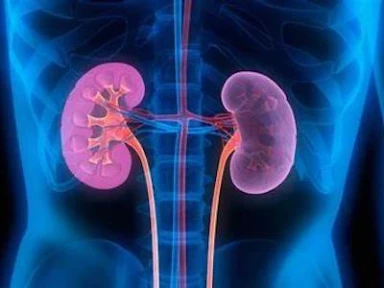Lenalidomide Refractory Patients
Welcome to the first edition of the Sanofi quarterly newsletter for 2023! These newsletters, created by Sanofi, aim to provide education to healthcare providers in relevant topics in multiple myeloma (MM). In this edition, we look at the increasing challenge of lenalidomide (len)-refractory disease in relapsed/refractory MM (RRMM), highlighting how widespread use of len-based regimens early in the treatment pathway has resulted in the emergence of a difficult-to-treat patient population with unmet medical need.
Early treatment for MM often includes len-based regimens as part of induction, consolidation, or as long-term maintenance. Therefore, many patients with RRMM have been previously exposed to and/or are refractory to len. Len-refractory MM is associated with poor clinical outcomes, as well as high disease burden, with few effective therapeutic options available.
In this issue
- The role of lenalidomide in MM
- Lenalidomide-refractoriness in MM
- Unmet needs in lenalidomide-refractory MM
- Summary
The role of len in MM
The substantial efficacy and manageable toxicity of len has resulted in this agent becoming the backbone of many combination regimens throughout the MM continuum and one of the most commonly used immunomodulatory drugs (IMiDs) worldwide.1,2 Len is used across frontline treatment for both transplant-eligible and -ineligible patients, including during induction, consolidation, as well as for maintenance therapy.3,4
Given the extensive use of len in the treatment of MM, most patients are exposed to len, frequently early in the course of therapy. In the latest data from the CoMMpass global prospective observational study (conducted in the US, Canada, Spain, and Italy), 52% of 1150 patients had a len-based first-line regimen and 45% had len-based second-line therapy (Figure 1).5
Figure 1: The proportion of patients receiving first-line (induction) or second-line treatment including len in the CoMMpass study (N=1150)5
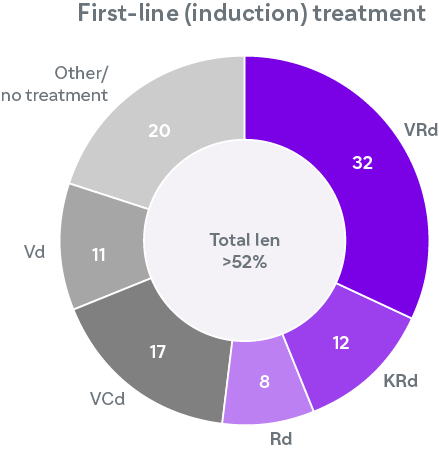
C, cyclophosphamide; d, dexamethasone; K, carfilzomib; len/R, lenalidomide; V, bortezomib
When maintenance regimens are taken into account, the proportion of patients receiving len for newly diagnosed MM (NDMM) rises even further. Data for 149 transplant-eligible patients treated from 2017 to 2020/2021 in France, Germany, Spain and Italy found that 93% of patients overall received len for NDMM (Figure 2).6
Figure 2: Induction and maintenance regimens used amongst Te NDMM patients in France, Germany, Spain and Italy (N=149)6
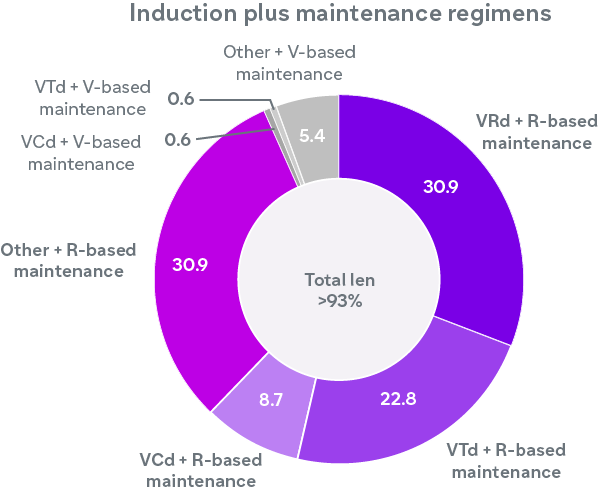
Prolonged therapy with len is common
Maintenance regimens are typically given until disease progression or intolerance, therefore treatment is often prolonged. In a retrospective study of 139 patients who received len maintenance during frontline therapy, the median duration of treatment was 21 months, and 25% of patients received len for >31 months (Figure 3).7
Figure 3: Real-world duration of len maintenance in NDMM patients (N=139)7
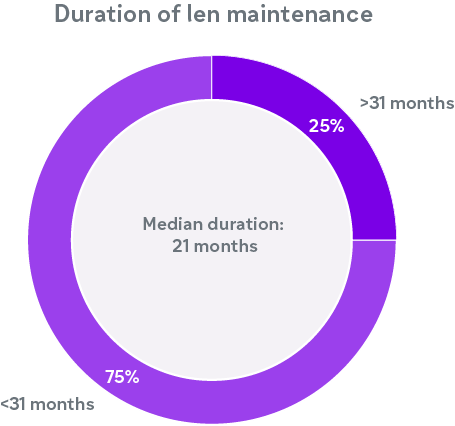
Duration of len-based treatment can also be lengthy in RRMM. In the INSIGHT MM prospective observational study, 821 patients received one or more lines of Rd-based therapy for RRMM, with median therapy durations up to ~14 months (Figure 4).8
Figure 4: Median duration of len treatment in RRMM patients in the INSIGHT MM observational study (N=821)8
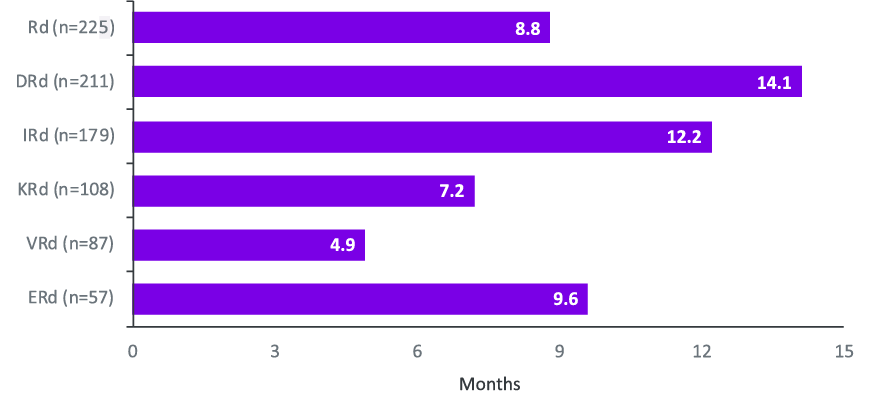
Len-refractoriness in MM
The widespread use of prolonged len-based regimens in frontline treatment has resulted in a high proportion of patients becoming len-refractory.9 According to the International Myeloma Working Group (IMWG), refractory MM is defined as disease that is nonresponsive to primary or salvage therapy (failure to achieve minimal response or development of progressive disease while on therapy) or progresses within 60 days of last therapy.10
The global prevalence of len-refractory patients is unclear as practices vary between countries; however, local registries provide some insights. In a retrospective, real-world UK study of patients with relapsed MM who were treated with len, 72% of 158 evaluable patients acquired len-refractory status.9 Similarly, a Danish retrospective study analyzing a population of NDMM and RRMM patients (N=303) found that 78% had previously received len, and 45% were considered len-refractory.11
Mechanisms of len-resistance
The mechanisms of len-resistance are complex and are not completely understood. However, the protein cereblon (CRBN) is the primary target for len and triggered downstream mechanisms elicit the vast majority of the pharmacological effects responsible for its anti-myeloma properties. Therefore, it has been suggested that acquired abnormalities in CRBN-related pathways in malignant plasma cells are likely to result in decreased len sensitivity or development of drug resistance.1 As such, low CRBN expression has been found to be associated with len-resistance in both preclinical studies and patients with MM.1,12
A number of other mechanisms are also thought to contribute to len-resistance;1 however, further research is required to fully understand these pathways with hopes to aid in the development of future therapeutic strategies.12
Unmet needs in len-refractory MM
Prognosis in len-refractory disease
The most important effect of len-refractory status in MM is its association with poor outcomes.9 A US retrospective analysis of medical records showed that patients who had len-refractory disease after first-line len-based therapy had both a shorter progression-free survival (PFS) and overall survival (OS) (Figure 5) than those who relapsed but were non-refractory.13
Figure 5: PFS (A) and OS (B) from start of second-line therapy in patients with len-refractory and len-relapsed disease in a retrospective study (N=279)13
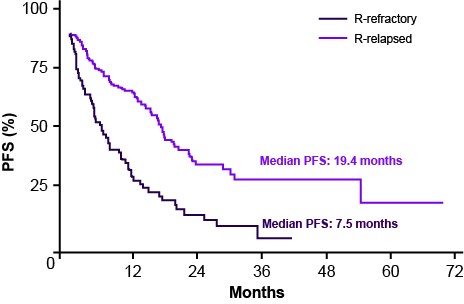
OS, overall survival; PFS, progression-free survival; R/len, lenalidomide
Similarly, a retrospective study of 312 patients who progressed on/after receiving frontline therapy with len found significantly shorter PFS at next line in patients refractory to len (regardless of dose received), compared with those who were non-refractory (Figure 6). These data suggest that resistance to len is not dose dependent.14
Figure 6: PFS at next line in patients refractory to low- and standard-dose len (N=312)14
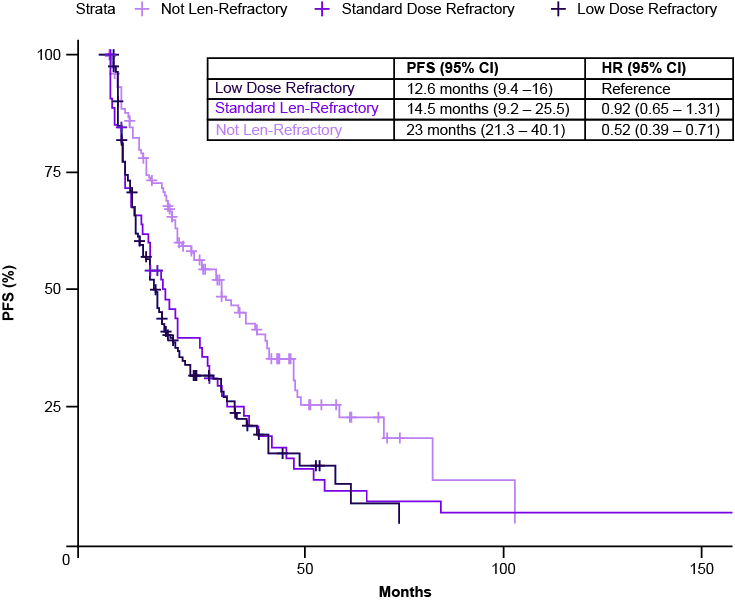
Higher disease burden associated with len-refractory disease
In addition to their poor prognosis, patients with len-refractory disease may have further characteristics that increase their level of unmet medical need. The CRAB features (hyperCalcemia, Renal failure, Anemia, and Bone lesions) are symptoms of end-organ damage commonly associated with MM.15 Comparison of medical records data from 279 patients who received len-based first-line therapy found that CRAB symptoms were more frequent in those with len-refractory than non-refractory disease at the initiation of second-line therapy, indicating a higher disease burden (Figure 7).13
Figure 7: Prevalence of CRAB symptoms in len-refractory and non-refractory MM at initiation of second-line therapy (N=279)13
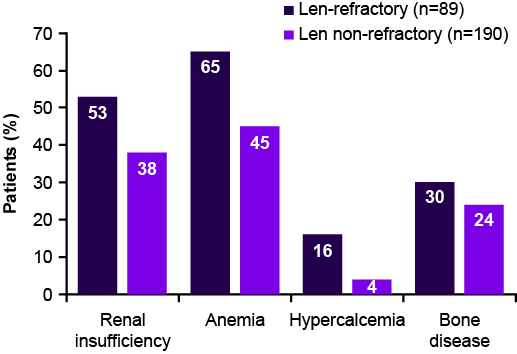
Similarly, significant levels of comorbidities are present in patients with len-refractory disease; US real-world data from claims and electronic health records found high levels of conditions such as hypertension and fluid/electrolyte disorders (Figure 8).16
Figure 8: Comorbidities seen in real-world populations of patients with len-refractory MM16
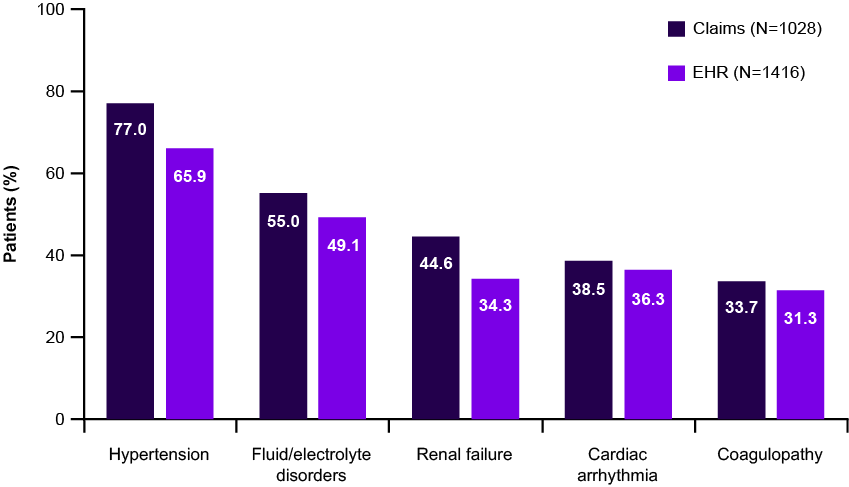
Additional challenges in len-refractory MM
Patients with len-refractory disease represent an ever-increasing proportion of the RRMM population, but there are a number of challenges associated with treatment selection that make this group difficult to treat. Although rechallenge with a drug that has previously proved effective can be a potential treatment strategy for those who are len-exposed but non-refractory,17 len-refractory status prevents the use of len in subsequent lines.18 Additionally, as the choice of therapy in RRMM needs to consider comorbidities (such as renal or cardiac failure) as well as the response to previous treatment,17 the higher disease burden in len-refractory MM further reduces the pool of potential options. Further, as the use of len in NDMM is so widespread, the len-refractory subgroup is highly heterogeneous,18 so it is possible that a single solution will not meet the needs of all patients. There is, therefore, a high unmet need for effective regimens in this increasing population of patients with poor prognosis, a high disease burden, and a limited number of available therapies (Figure 9).9,19
Figure 9: Unmet needs in len-refractory MM9,13,16,18-20

SUMMARY
Since its approval in MM approximately two decades ago, len has become the backbone of many standard-of-care regimens, with the majority of patients being exposed to this agent early in their treatment journey. The widespread and prolonged use of len has resulted in a high number of patients developing len-refractory disease.
Len-refractory disease is associated with poor outcomes, and as such, patients tend to have a higher disease burden than those without len-refractory MM. It is therefore important to ensure that approved regimens are accessible to patients in this hard-to-treat population.
ASCT, autologous stem cell transplant; CRBN, cereblon; IMiD, immunomodulatory drug; IMWG, International Myeloma Working Group; len, lenalidomide; MM, multiple myeloma; NDMM, newly diagnosed multiple myeloma; OS, overall survival; PFS, progression-free survival; R, lenalidomide; Rd, lenalidomide and dexamethasone; RRMM, relapsed/refractory multiple myeloma
- Kulig P, et al. Cancers 2023;15:963
- Barankiewicz J, et al. Cancers 2022;14:4492
- NCCN guidelines v3.2023 Available at: https://www.nccn.org/guidelines/category_1
- Dimopoulos MA, et al. Ann Oncol 2021;32:309–22
- The MMRF CoMMpassSM Study. Available at: https://themmrf.org/finding-a-cure/our-work/the-mmrf-commpass-study
- Weisel K, et al. Eur J Haematol 2022;109:388–97
- Alonso R, et al. Blood Adv 2020;4:2163–71
- Puig N, et al. EHA 2021; Abstract EP985
- Lecat CSY, et al. Front in Oncol 2021;11:703233
- Rajkumar SV, et al. Blood 2011;117:4691–5
- Szabo AG, et al. Clin Hematol Int 2019;1:220–8
- Martinez-Høyer S & Karsan A. Exp Hematol 2020;91:22–31
- Jhaveri M, et al. EHA 2016; Abstract E1312
- Goel U, et al. Blood 2022;140:9998–99
- Rajkumar SV, et al. Lancet Oncol 2014;15:e538–48
- Dhakal B, et al. EHA 2022; Abstract P899
- Hernández-Rivas J-A, et al. Biomarker Res 2022;10:1
- de Arriba de la Fuente F, et al. Cancers 2023;15:155
- Mateos M-V, et al. Blood 2020;136(Supp. 1):22–3 20. Moreau P, et al. Blood Cancer J 2019;9:38

.jpg/jcr:content/jcr_content%20(14).jpg)

